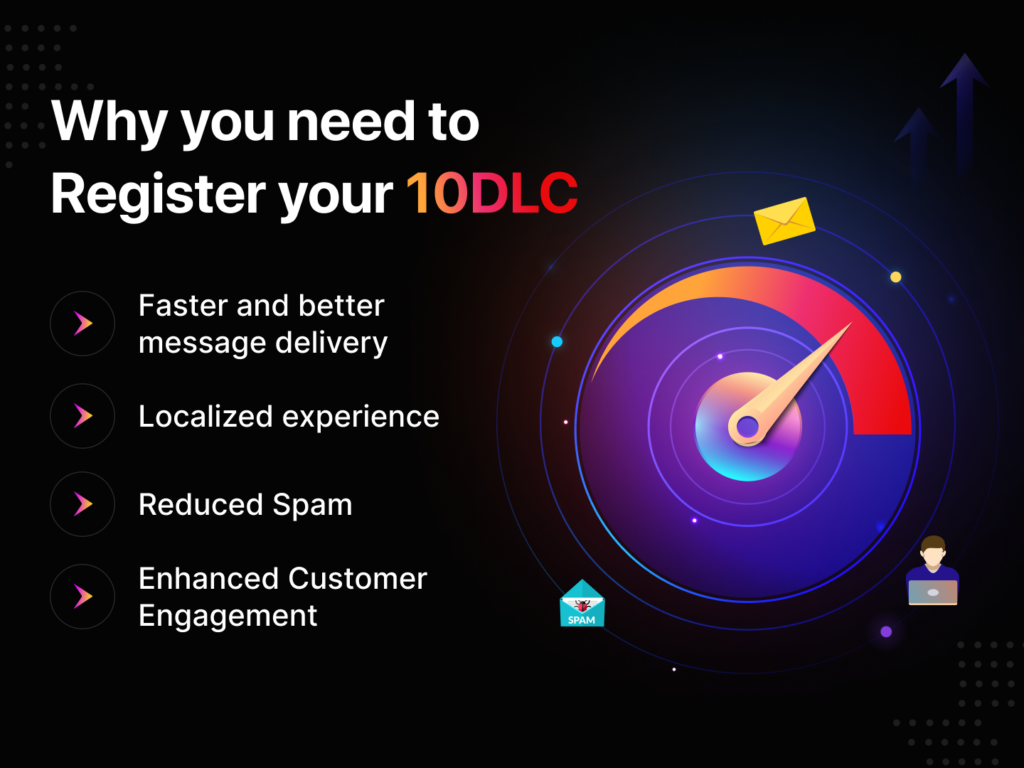How does brand registration work?
Step 1: Gather Your Business Information
To begin the process of registering your business for 10DLC (10-Digit Long Code) texting, you’ll need to provide some essential details, including:
- Your company’s official legal name.
- The country where your company is registered.
- Your organization type (private, publicly traded, nonprofit).
- Your company’s tax number, ID, or EIN (Employer Identification Number).
- Your business website.
- Descriptions of each purpose for which you intend to send text messages.
- Sample messages for each of these intended purposes.
Step 2: Submit Registration for Your “Brand”
In 10DLC, a “brand” represents the business that sends text messages. A single brand can manage multiple “campaigns” under its account.
Step 3: Submit Registration for Your Texting “Campaign(s)”
A 10DLC campaign defines a specific use case for sending text messages.
If you plan to send texts for various purposes, there is an option for a “mixed” use case that covers a range of scenarios.
Each campaign can be associated with up to 50 different 10DLC phone numbers.
Step 4: Await Approval or Rejection from The Campaign Registry
The good news is that you’ll receive a response almost immediately after submitting your registration. However, there’s one more step before you can start texting.
Step 5: Submit Your Registration for DCA Vetting
Every campaign registration must undergo a DCA (Direct Connect Administrator) verification process.
You must verify that the contacts you intend to message have legitimately agreed to receive messages from your company.
What is a Trust Score, and how does it affect me?
A Trust Score, or a Brand Score or Reputation Score, is a numerical rating given to a business during the brand registration with a third-party corporation that manages a system used by US cellular carriers.
This score serves to evaluate the brand’s credibility and messaging tactics. The Trust Score is generally between 0 and 100, with higher scores indicating greater trustworthiness.
This is how the trust code can affect your business:
Messaging throughput (MPS): The Trust Score is important in calculating messaging throughput or message-sending capacity for your brand’s A2P (Application-to-Person) 10DLC (10-digit long code) campaigns.
A higher Trust Score often supports more throughput, which means you can send more text messages per second and have higher daily messaging limits for your campaigns.
Campaign performance: A higher Trust Score might result in faster message distribution and lower costs for your campaigns, leading to better performance and more effective communication with your audience.
Campaign eligibility: Trust Scores may assist you in deciding whether your brand is acceptable for different ad kinds or messaging limitations set by carriers.
Lower-scoring brands may have fewer options or lower tiers on some carriers.
Vetting process: To get a Trust Score, businesses may be submitted to a verification procedure that evaluates certain brand factors such as reputation, business practices, and industry standards.
This procedure helps carriers identify trustworthy brands and prevent spam or unwanted messaging.
Appeals: If you feel your Trust Score is inaccurate or wish to improve it, you might be able to file an appeal or request help from the support staff of the third-party business in charge of assigning Trust Scores.
Score stability: Trust scores are often stagnant and do not change automatically over time, so they stay constant unless the business requests a review or appeal.
How do Trust Scores influence message throughput?
Trust Scores are crucial in determining message delivery speed when using A2P 10DLC for business text messaging software.
These scores categorize behavior, compliance, and sender reputation from Lowest to Highest.
Your Trust Score and your campaign type influence message delivery speed, measured in message segments per second (MPS)—a high Trust Score and successful campaign grant higher message throughput, enabling faster message sending.
Once approved for A2P 10DLC and registered, your Trust Score and campaign type decide on message delivery.
Trust Scores impact throughput for AT&T and Verizon users. Message throughput is no longer solely tied to MPS but also considers Trust Scores and campaign types.
When should I consider getting started with 10DLC?
If you’re a business and want to send text messages to customers in the United States for marketing, transactions, appointment reminders, or customer service, you should consider using 10DLC.
Since 10DLC is supported by US phone carriers, messages received by this method are less likely to be censored as long as they meet the conditions set upon registration.
How long is the registration process?
It is important to plan for a potentially longer approval process, which can take up to 30 business days.
Having the required documents and information ready can help speed up the process.
If you want a quicker solution, you may use a toll-free number and have your traffic verified within 7 working days. This option, however, may not be suitable for many companies.








